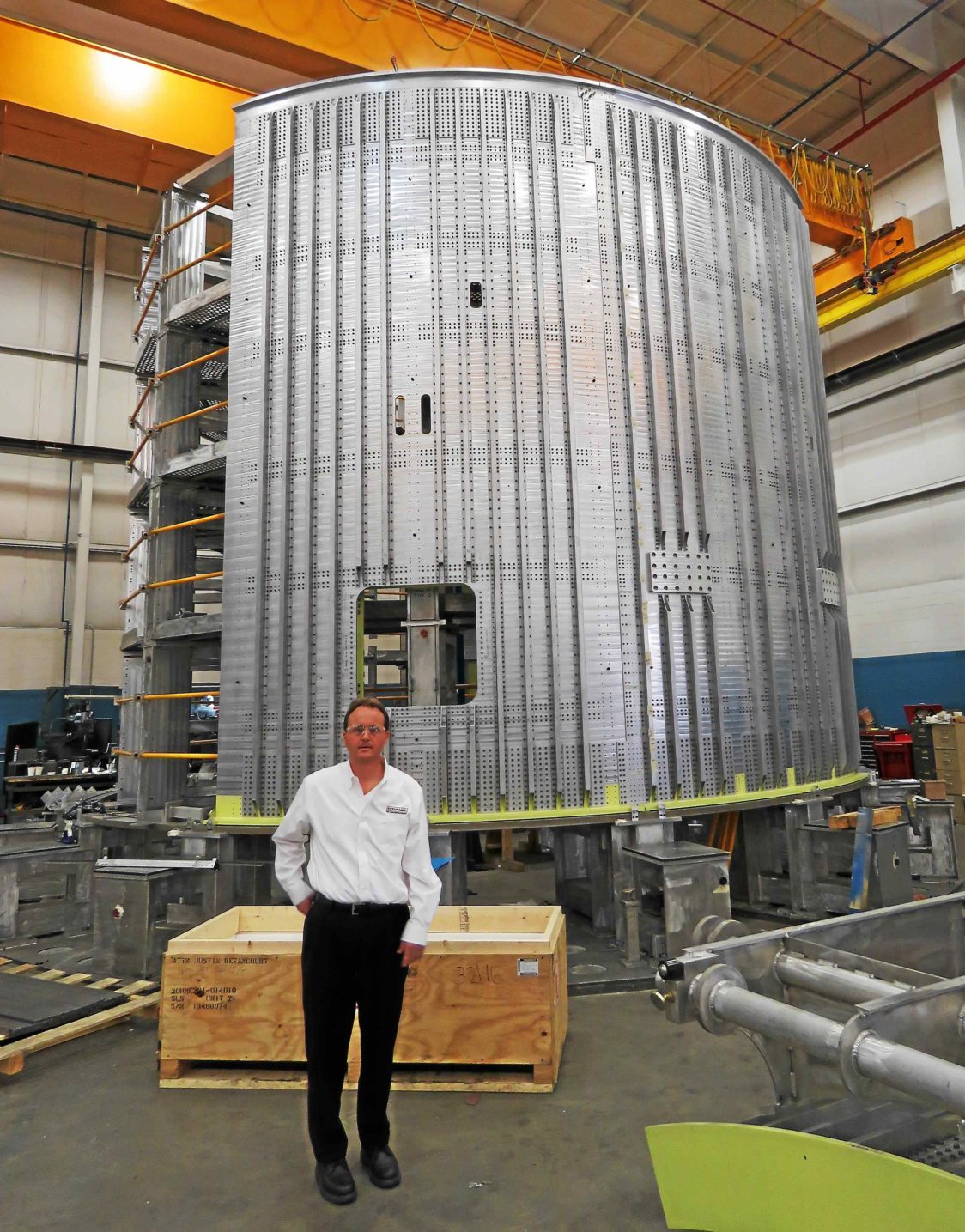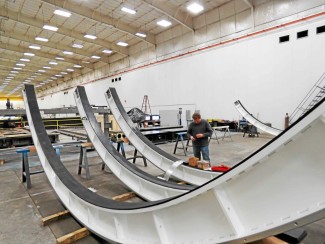Macomb Township company helps NASA with mission to Mars
Article From The Macomb Daily
Originally Posted: May 14, 2016
A Futuramic employee works on three pieces that will get bolted together around the barrel of the fuel tank to rotate it. Jim Bloch — For The Macomb Daily
Long known for auto plants and a thriving blue economy revolving around its lakefront, Macomb County is getting into the next chapter of space exploration.
A local firm is building components and tooling for the spaceship that will take astronauts to Mars.
“A lot of the work we’ve been doing lately is for the new Space Launch System, which is the rocket that’s going to power the Orion capsule to Mars,” said John Couch, vice president of Futuramic Tool and Engineering in Warren.
The name of the firm contains echoes of the classic days of The Right Stuff.
Oldsmobile produced the Futuramic in 1949 and 1950.
The namesake firm spent its first 48 years in the automotive industry.
“We were 100 percent automotive until 2000,” said Couch. “We were full service for Ford Motor Company. We built every single checking fixture for them. Then they started taking work to Mexico in 2001 and we had to start diversifying. Today, we’re 95 percent aerospace.”
MANUFACTURING FOR MARS
Futuramic is family-owned and employs 275 people in 600,000 square feet of space on its original campus near 10 Mile and Hoover roads as well as its new digs in Detroit.“Most of the components we’re currently making are being shipped down to New Orleans to NASA’s Michoud Assembly Facility and we’re reassembling them down there on site so they can build this rocket,” said Couch. “Lockheed Martin is the prime contractor on Orion capsule and we do work for them. They’re building the capsule at Michoud.”
Astronauts will travel into deep space aboard the Orion’s crew module.
Boeing is the prime contractor for the core of Space Launch System, also being assembled at Michoud.
“The core stage of the rocket lifts the capsule off Earth into lower orbit,” said Couch.
From lower orbit, the altitude of the space station, the SLS, will fire Orion toward Mars.
“A lot of our work is for the fuel tanks and the engine sections,” said Couch. “The core stage is 180 feet tall, 28 feet in diameter. So a lot of the components are very large. Of the five major weld tools procured by NASA for the SLS, we built three of them.”
In Plant 2, the firm is assembling two structural simulators that will subject the fuel tanks to the kinds forces and loads associated with launch to test their integrity.
“We’re doing the thrust beams where the engines mount,” said Couch. “We’re also making some of the actual skin panels for the hydrogen tanks.”
In December 2014, NASA launched the Orion into two orbits around Earth on its initial test flight. The agency is hoping for a second un-crewed mission beyond the moon in 2018. The tentative date for the first crewed mission is 2023.
“It’s been a great project,” said Couch. “It’s different. It’s fun.”
Though figures are not clear, it is estimated the early stages of the project, before a manned mission is attempted, will cost from $19-22 billion.
POLITICAL CLOUT
There have been few Federal programs that can match NASA’s effort to put men on the moon in the 1960s in terms of sparking a national sense of discovery, adventure and unity, not to mention the huge scientific and technological bounty of the Apollo program.Can a Mars shot recapture that?
“No question about it,” said U.S. Senator Gary Peters. “I know how spellbound I was watching the landing on the moon. I see that same inspiration on the faces of young employees now at companies like Futuramic in Macomb County.”
Peters is the ranking member on the subcommittee of U.S. Senate Committee on Commerce, Science and Transportation that oversees NASA.
“He’s been a huge advocate,” said Couch.
Would Peters like to ride Orion into deep space?
“I would love to,” the senator said.
What about claustrophobia? The Mercury and Apollo capsules were shockingly small.
“Orion offers a larger living space than Apollo,” said Peters.
There are 316 cubic feet of living space for four astronauts aboard Orion versus 210 cubic feet in the command module of Apollo for three astronauts. That’s 79 cubic feet per person aboard Orion versus 70 cubic feet per person aboard Apollo. Those selected for the manned mission would be in space for an estimated 2 1/2 years. Once on the red planet, they would have to stay 18-20 months to allow for planets to properly align for a return mission.
“But I don’t think that’s in the cards for me,” Peters said. “It will take six months or so to get to Mars and another six to get back. Not only will their living space be small, but space presents an extremely hostile environment outside the spacecraft. The astronauts will be very brave and very adaptable individuals.”
Copyright 2016 by The Macomb Daily – All rights reserved.


